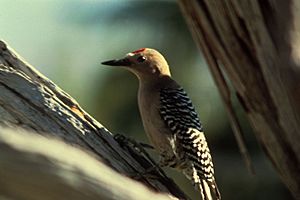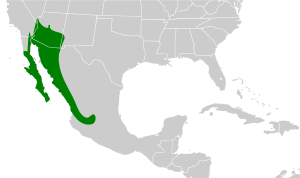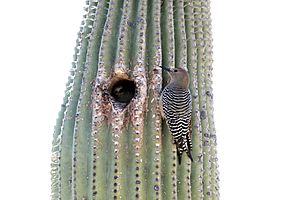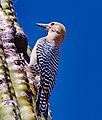Gila woodpecker facts for kids
Quick facts for kids Gila woodpecker |
|
|---|---|
 |
|
| Conservation status | |
| Scientific classification | |
| Genus: |
Melanerpes
|
| Species: |
uropygialis
|
 |
|
| Distribution (green) | |
The Gila woodpecker (Melanerpes uropygialis) is a cool, medium-sized woodpecker that lives in the desert areas of the southwestern United States and western Mexico. In the U.S., you can find them in southeastern California, southern Nevada, Arizona, and New Mexico. These birds are well-known for making their homes in saguaro cacti!
Contents
What Does a Gila Woodpecker Look Like?

The back and wings of this bird have a neat black and white pattern, a bit like a zebra. Their neck, throat, belly, and head are a soft greyish-tan color. If you see a male Gila woodpecker, you'll notice a small red patch on the top of its head. Females and young birds look similar, but they don't have this red cap.
When these woodpeckers fly, you can easily spot white patches on their wings. Their dark tail has white stripes on the middle feathers. These birds are usually about 8 to 10 inches (20 to 25 cm) long.
Gila Woodpecker Sounds
The Gila woodpecker has a few different calls. One sound they make is a rolling churr. They also have a quick yip yip yip sound and a kee-u, kee-u, kee-u call. When they drum on trees, it's a long and steady rhythm.
Where Do Gila Woodpeckers Live?
This woodpecker's home is usually in the hot, dry desert areas, especially in the Sonoran Desert. They also like to live near dry riverbeds, which are called arroyos or washes, and sometimes even in small towns.
Gila Woodpecker Behavior and Life Cycle
Reproduction
Gila woodpeckers build their nests inside holes they make in saguaro cacti or mesquite trees. The holes they dig in saguaro cacti are often called "boots" because of their shape. After the Gila woodpeckers leave, other animals like the elf owl often use these empty holes as their homes.
Female Gila woodpeckers usually lay 3 to 4 white eggs, but sometimes they can lay as many as 6 or 7. They can have 2 to 3 groups of babies (broods) each year. Both the male and female woodpeckers take turns sitting on the eggs to keep them warm (this is called incubating) and feeding their young chicks.
What Gila Woodpeckers Eat
As a woodpecker, a big part of their diet is insects. They find these insects by drilling into tree bark. But Gila woodpeckers are also omnivorous, which means they eat both plants and animals. They enjoy fruits, nectar (the sweet liquid from flowers), and seeds. They also eat small animals like lizards, worms, and even the eggs or young chicks of other small birds. You might even see them hanging upside down on human-made hummingbird feeders, sipping the sweet nectar!
Gila Woodpecker Status
The IUCN (International Union for Conservation of Nature) says that the Gila woodpecker is a species of "least concern." This means they are not currently in danger of disappearing around the world. However, in California, they are considered an endangered species because their numbers have gone down a lot there. In Arizona, there are still many Gila woodpeckers. One thing that could cause problems for these birds in the future is climate change, which might reduce the places they can live.
Gallery
See also
 In Spanish: Melanerpes uropygialis para niños
In Spanish: Melanerpes uropygialis para niños






